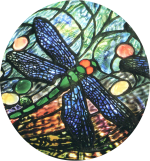
During the Gilded Age just before the turn of the twentieth century, Tiffany forged his reputation in stained-glass. His highly recognizable style blended Art Nouveau, the exoticism of the Aesthetics Movement, and his own adoration of nature.
Until recently, it was assumed that he was the designer of the celebrated leaded-glass lampshades. However, two collections of letters reveal that an unrecognized woman, Clara Driscoll, designed the floral shades as well as many of the bronze bases.
Clara and Mr. Tiffany
presents these two figures--one the giant of American decorative arts, the other unknown--as they engage each other, collaborating, probing and frustrating each other, stumbling over their passions.
Driven by the Tiffany Family Imperative to honor his father, owner of Tiffany & Co., by surpassing his elder's fame and financial success, Tiffany confronts the central issue in the Arts and Crafts debate: art versus industry, and its concomitant, creative indulgence versus financial restraint.
Yearning to establish herself as a creator of exquisite pieces of art, and to be recognized publically, Clara is a vibrant, intelligent, wry woman, a leader whose challenge, like that of many women, is to decide what makes her most happy--the professional world of her hands, or the personal world of her heart.
The novel interprets her creative and personal life, her loves, losses, triumphs, and her startling decisions.
|







 Order Now
Order Now
